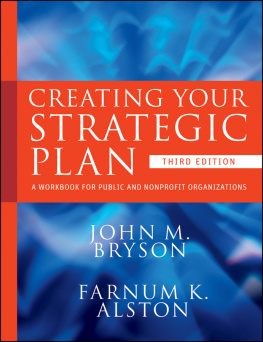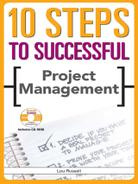10 STEPS TO
Successful
Strategic Planning

Susan Barksdale and Teri Lund

Alexandria, Virginia
November 2006 by the American Society for Training & Development.
All rights reserved. Printed in the United States of America.
10 09 08 07 06 1 2 3 4 5
No part of this publication may be reproduced, distributed, or transmitted in any form or by any means, including photocopying, recording, or other electronic or mechanical methods, without the prior written permission of the publisher, except in the case of brief quotations embodied in critical reviews and certain other noncommercial uses permitted by copyright law. For permission requests, please refer to the Rights & Permissions section on the ASTD Online Store website at store.astd.org or write to ASTD Rights & Permissions, Publications Department, Box 1443, Alexandria, VA 22313-1443.
ASTD Press is an internationally renowned source of insightful and practical information on workplace learning and performance topics, including training basics, evaluation and return-on-investment (ROI), instructional systems development (ISD), e-learning, leadership, and career development.
Ordering information: Books published by ASTD Press can be purchased by visiting our website at store.astd.org or by calling 800.628.2783 or 703.683.8100.
Library of Congress Control Number: 2006932460
ISBN-10: 1-56286-457-2
ISBN-13: 978-1-56286-457-6
ASTD Press Editorial Staff
Director: Cat Russo
Manager, Acquisitions & Author Relations: Mark Morrow
Editorial Manager: Jacqueline Edlund-Braun
Editorial Assistant: Kelly Norris
Copyeditor: Christine Cotting
Indexer: April Davis
Proofreader: Kris Patenaude
Interior Design and Production: UpperCase Publication Services, Ltd.
Cover Design: David Cooper
Printed by Victor Graphics, Inc., Baltimore, Maryland, www.victorgraphics.com.
10 STEPS TO SUCCESS
Let's face it, most people spend their days in chaotic, fast-paced, time- and resource-strained organizations. Finding time for just one more project, assignment, or even learning opportunityno matter how career enhancing or usefulis difficult to imagine. The 10 Steps series is designed for today's busy professional who needs advice and guidance on a wide array of topics ranging from project management to people management, from business planning strategy to decision making and time management, from return on investment to conducting organizational surveys and questionnaires. Each book in this new ASTD series promises to take its readers on a journey to basic understanding, with practical application the ultimate destination. This is truly a just-tell-me-what-to-do-now series. You will find action-driven language teamed with examples, worksheets, case studies, and tools to help you quickly implement the right steps and chart a path to your own success. The 10 Steps series will appeal to a broad business audience from middle managers to upper-level management. Workplace learning and human resource professionals along with other professionals seeking to improve their value proposition in their organizations will find these books a great resource.
PREFACE
Most successful organizations practice strategic planning. These organizations benefit not only from having a plan, but also from the planning process itself. The plan is the road map to success, and the planning process unites organizational leadership and enhances the communicating of critical company information. Today's volatile marketplace demands that employees, work groups, and organizations have a clear understanding of their roles, the products and services they offer, and the processes they use to navigate the continually changing waters they sail. A strategic plan that is directly related to group and individual planning provides an opportunity to create an outcome-based organization culture.
In the face of rapid change, organizations have realized they cannot compete on a global basis without a strategic plan that encourages innovation and creates knowledge internally and that builds customer loyalty to their products and services. A strategic plan provides the path an organization will take in the future (whether it will stay on course or follow a different direction than in the past); the predictions of how the marketplace, customer base, and product line will change or react to the future; and the calculated risk that the organization will need to bear to move in that direction. During strategic planning, organizations set their priorities for the next two to five years and identify how major resources will be allocated. If done correctly, the strategic plan should be a document that motivates employees to achieve the plan's stated goals and tactics. When realignment or redirection takes place, it is the strategic plan that explains the change in direction and refocuses the organization's efforts by redefining the organizational goals and major tactics.
But how do you develop a successful plan? The 10 Steps to Successful Strategic Planning is process driven and comprises the following 10 steps:
laying the foundation for the plan
scanning the business environment
collecting relevant data
analyzing collected data
stating mission, vision, and values
prioritizing needs and identifying risks
designing and validating tactics
prioritizing tactics and resources
documenting and communicating the plan
maintaining the plan.
Strategic planning provides a plethora of opportunities for an organization, such as facilitating discussion and analysis of past performance using a methodical approach, providing a method to prioritize performance needs and organization goals, supplying information that will assist in prioritizing resources, and enabling the organization to be proactive rather than reactive and therefore more in control. Developing a plan will enable your organization to
 ensure the products and services delivered to its customer base are consistent and of high quality
ensure the products and services delivered to its customer base are consistent and of high quality
 appraise past performance and identify successes and areas for future improvement
appraise past performance and identify successes and areas for future improvement
 create a consistent, sharp marketing message that promotes realistic expectations about the organization
create a consistent, sharp marketing message that promotes realistic expectations about the organization
 promote better use of resources (people, things, time, and finances)
promote better use of resources (people, things, time, and finances)
 manage customer expectations
manage customer expectations
 limit resource investment in activities that do not provide results
limit resource investment in activities that do not provide results
 encourage individuals to be more proactive and resourceful in problem solving through understanding how the strategy affects their responsibilities and accountabilities
encourage individuals to be more proactive and resourceful in problem solving through understanding how the strategy affects their responsibilities and accountabilities













 ensure the products and services delivered to its customer base are consistent and of high quality
ensure the products and services delivered to its customer base are consistent and of high quality